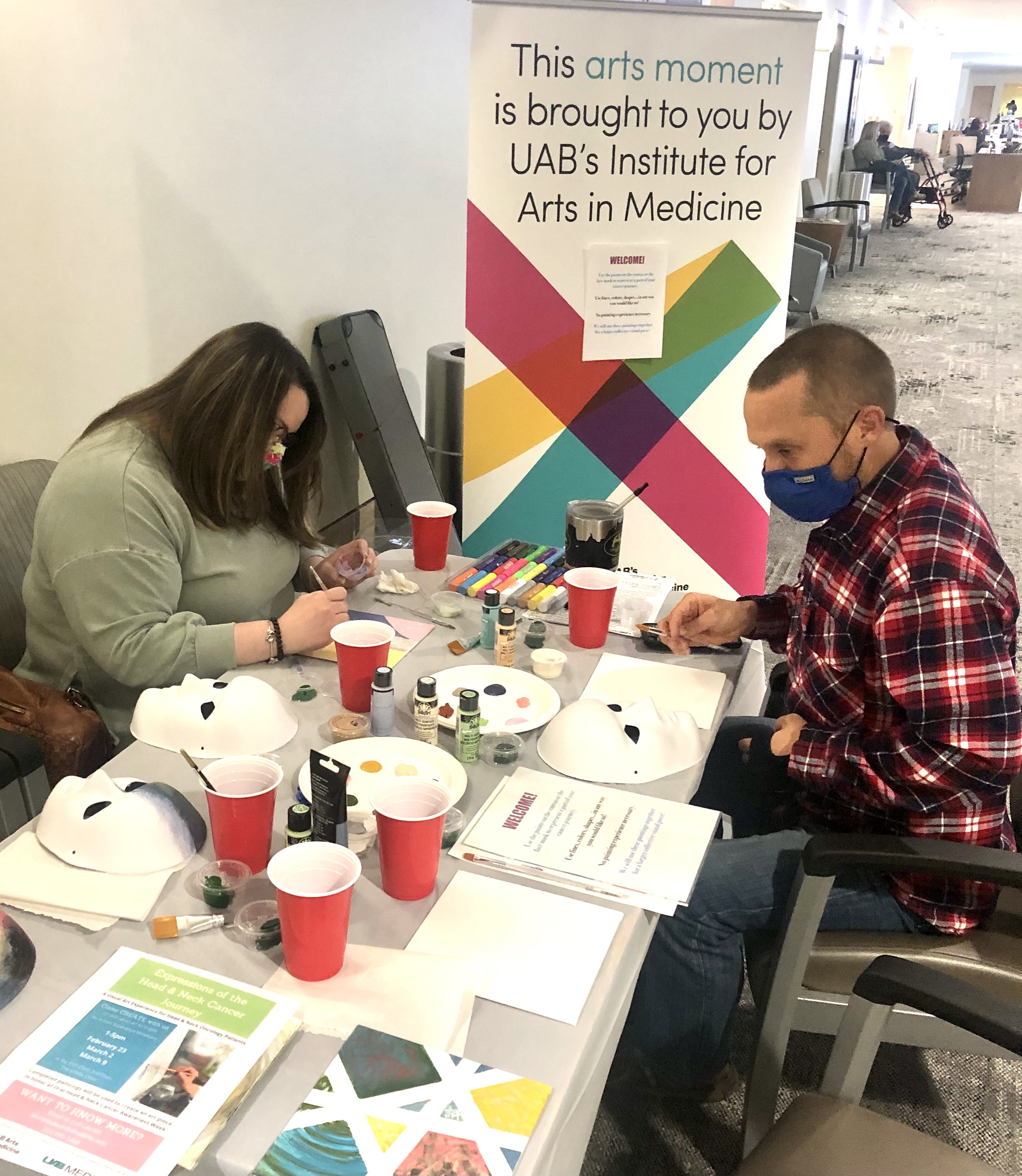 The Otolaryngology Department collaborates with UAB Arts in Medicine to bring head and neck cancer patients a different kind of healing.
The Otolaryngology Department collaborates with UAB Arts in Medicine to bring head and neck cancer patients a different kind of healing.
If you happened to walk through the halls of The Kirklin Clinic’s ENT practice in March, you might have noticed something unique happening. Patients, caregivers and staff came together to work on an art project, connecting with one another through color choices and painted canvases.
Sometimes art speaks louder than words. That’s been one of the biggest revelations of the recent “Expressions of the Head & Neck Cancer Journey” project, launched in March.
Carissa Thomas, M.D., Ph.D., FACS, Assistant Professor and Director of Head and Neck Microvascular Reconstruction for UAB’s Otolaryngology Department and the O’Neal Comprehensive Cancer Center, initiated the project. She wanted to provide an opportunity for patients, family members and caregivers to be able to express a part of their journey through painting.
An Idea Takes Root
“The idea started with a clinic visit with a patient,” Thomas said. She explains that her patient shared the experience of journaling while undergoing treatment at the O’Neal Comprehensive Cancer Center. “The things that she wrote were powerful.” From there, the idea evolved into a different direction and a collaboration with the Arts in Medicine group.
Valerie Hanks, an art therapist for UAB’s Arts in Medicine program, brought the idea to life. She led head and neck oncology patients and families through this project, encouraging them to paint original artwork onto masks and canvases representing their individual journeys. “There has been a range of expressions, from ones who painted a symbolic portrayal of their journey to others who have drawn art on the mask where their cancer was located,” Hanks said. For some patients who had temporarily lost their voice to head and neck cancer, the canvas provided a way to speak.
While some completed their projects on-site, others opted for a take-home art kit to use in the privacy of their home. For the ones completing their art in the clinic, this project provided a pathway to discuss their experience with others undergoing similar circumstances. It sparked conversations and helped to ease anxiety as they waited for their next appointment.
Hanks is mindful of the vulnerability that a project like this can access. “I am very honored to share in this vulnerable time with patients and families and come alongside creatively to better understand their experiences.”
The Power of Choice
She uses the time to allow patients to access the power of choice. “When they make choices about their art, they take back some control which may have been lost during their battle with cancer,” Hanks said. She brings a variety of mediums, paints and colors for them to choose from. “I put them in the art director chair.”
Upon completing a piece, Hanks asks each patient to title it and share the meaning behind it. In doing so, they find a safe place to share and reflect. Through this process, Hanks observes that patients are expressing a lot of hope.
One unexpected benefit to the project? It provided a healing release for nurses and caregivers. “Taking care of head and neck oncology patients can be emotionally difficult as well, so it’s really nice for the providers to also have an opportunity to express what they are dealing with day to day,” Thomas said.
After all pieces were completed, Hanks helped to weave together their work into one cohesive installation. The composite piece, which will be on display in the ENT Kirklin Clinic, is a tapestry of the head and neck cancer experience, highlighting the journey in a way that words simply cannot capture.
It’s critical not only to healing but also to raising awareness. “A lot of people focus on screening and education, but this is unique because we are still educating people but more on a personal level,” Thomas said. She has received a community outreach grant from the American Head & Neck Society to build upon this initial effort.
UAB Arts in Medicine (AIM) began in 2013, with the mission to transform the care environment and enhance well-being and healing through creative arts experiences. Under the direction of Kimberly Kirklin, AIM employs artists from many disciplines — visual arts, music, expressive writing, poetry, storytelling, dance, movement and yoga. Research has shown that integrating the arts into the healthcare environment can benefit patients and caregivers by reducing stress levels, perceived pain and improving mood, among many other benefits.
UAB Head and Neck Oncology is part of the O'Neal Comprehensive Cancer Center, one of the original eight centers in the United States designated by the National Cancer Institute. We are thankful to have AIM as a partner in healing. Working together, we hope to provide new and innovative healing opportunities for all head and neck oncology patients.